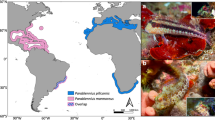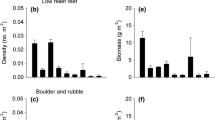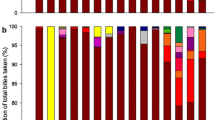Abstract
Ecological niches hold critical information concerning the eco-evolutionary dynamics that govern biodiversity and abundance patterns. Cryptobenthic reef fishes account for approximately half of all reef fish species and are an abundant and important group on coral reefs worldwide. Yet, due to their small size and inconspicuous lifestyles, relatively little is known about the ecological niches of most cryptobenthic species. Here, we use gut content DNA metabarcoding to determine dietary niche overlap and prey richness in four sympatric species of cryptobenthic reef fishes in two genera (Acanthemblemaria aspera, A. spinosa, Enneanectes altivelis, and E. matador). Furthermore, we test whether dietary differentiation corresponds with differences in species distribution patterns across twelve sites on the Mesoamerican Barrier Reef in Belize. Our approach reveals dietary partitioning among the four species, which is further supported by low edge density and high modularity in the resulting trophic network. A. spinosa and E. matador consume a significantly higher richness of prey items than their congeners. This result corresponds with non-random distributions and co-occurrence patterns in both species pairs: the two high prey richness species (A. spinosa and E. matador) co-occur more frequently than predicted by chance, but they are exclusive to exposed forereef sites with high wave action. In contrast, their congeners occur across exposed forereef and sheltered backreef sites, but they do not increase in numbers at sheltered sites. Our findings suggest that A. spinosa and E. matador monopolize a wide variety of prey in exposed habitats, but they are unable to meet the energetic demands of their adaptation to high-flow habitats in sheltered areas, possibly due to lower prey availability. This, in turn, indicates strong ecological differentiation among closely related species of cryptobenthic fishes, driven by links between diet, physiology, prey availability, and wave exposure.






Similar content being viewed by others
Data accessibility
All data and code necessary to reproduce the results of the present paper are available on Zenodo (10.5072/zenodo.472332).
References
Ackerman JL, Bellwood DR (2002) Comparative efficiency of clove oil and rotenone for sampling tropical reef fish assemblages. J Fish Biol 60:893–901
Ackerman JL, Bellwood DR (2000) Reef fish assemblages: a re-evaluation using enclosed rotenone stations. Mar Ecol-Progress Ser 206:227–237
Ahmadia GN, Tornabene L, Smith DJ, Pezold FL (2018) The relative importance of regional, local, and evolutionary factors structuring cryptobenthic coral-reef assemblages. Coral Reefs 37:279–293
Andrades R, Andrade JM, Jesus-Junior PS, Macieira RM, Bernardino AF, Giarrizzo T, Joyeux J-C (2019) Multiple niche-based analyses reveal the dual life of an intertidal reef predator. Mar Ecol Progress Ser 624:131–141
Barnett A, Bellwood DR, Hoey AS (2006) Trophic ecomorphology of cardinalfish. Mar Ecol Progress Ser 322:249–257
Bejarano S, Jouffray J, Chollett I, Allen R, Roff G, Marshell A, Steneck R, Ferse SC, Mumby PJ (2017) The shape of success in a turbulent world: wave exposure filtering of coral reef herbivory. Funct Ecol 31:1312–1324
Bellwood DR, Wainwright PC, Fulton CJ, Hoey AS (2006) Functional versatility supports coral reef biodiversity. Proc R Soc Lond B Biol Sci 273:101–107
Bradley CJ, Longenecker K, Pyle RL, Popp BN (2016) Compound-specific isotopic analysis of amino acids reveals dietary changes in mesophotic coral-reef fish. Mar Ecol Progress Ser 558:65–79
Brandl SJ, Bellwood DR (2014) Individual-based analyses reveal limited functional overlap in a coral reef fish community. J Animal Ecol 83:661–670
Brandl SJ, Casey JM, Knowlton N, Duffy JE (2017) Marine dock pilings foster diverse, native cryptobenthic fish assemblages across bioregions. Ecol Evol 7:7069–7079
Brandl SJ, Goatley CH, Bellwood DR, Tornabene L (2018) The hidden half: ecology and evolution of cryptobenthic fishes on coral reefs. Biol Rev 93:1846–1873
Brandl SJ, Rasher DB, Côté IM, Casey JM, Darling ES, Lefcheck JS, Duffy JE (2019a) Coral reef ecosystem functioning: eight core processes and the role of biodiversity. Front Ecol Environ 17:445–454
Brandl SJ, Tornabene L, Goatley CHR, Casey JM, Morais RA, Côté IM, Baldwin CC, Parravicini V, Schiettekatte NMD, Bellwood DR (2019b) Demographic dynamics of the smallest marine vertebrates fuel coral reef ecosystem functioning. Science 364:1189–1192
Casey JM, Meyer CP, Morat F, Brandl SJ, Planes S, Parravicini V (2019) Reconstructing hyperdiverse food webs: gut content metabarcoding as a tool to disentangle trophic interactions on coral reefs. Methods Ecol Evol 10:1157–1170
Castellanos-Galindo GA, Giraldo A (2008) Food resource use in a tropical eastern Pacific tidepool fish assemblage. Mar Biol 153:1023–1035
Chao A, Gotelli NJ, Hsieh T, Sander EL, Ma K, Colwell RK, Ellison AM (2014) Rarefaction and extrapolation with Hill numbers: a framework for sampling and estimation in species diversity studies. Ecol Monogr 84:45–67
Chesson P, Pacala S, Neuhauser C (2001) Environmental niches and ecosystem functioning. Functional Consequences of Biodiversity, p 213–245
Choat JH, Clements KD, Robbins WD (2002) The trophic status of herbivorous fishes on coral reefs. Mar Biol 140:613–623
Clarke RD (1992) Effects of microhabitat and metabolic rate on food intake, growth and fecundity of two competing coral reef fishes. Coral Reefs 11:199–205
Clarke RD (1996) Population shifts in two competing fish species on a degrading coral reef. Marine Ecology Progress Series, pp 51–58
Clarke RD (1999) Diets and metabolic rates of four Caribbean tube blennies, genus Acanthemblemaria (Teleostei: Chaenopsidae). Bull Mar Sci 65:185–199
Clarke RD, Finelli C, Buskey E (2009) Water flow controls distribution and feeding behavior of two co-occurring coral reef fishes: II. Labor Exp Coral Reefs 28:475–488
Clavel J, Julliard R, Devictor V (2011) Worldwide decline of specialist species: toward a global functional homogenization? Front Ecol Environ 9:222–228
Clements KD, German DP, Piché J, Tribollet A, Choat JH (2016) Integrating ecological roles and trophic diversification on coral reefs: multiple lines of evidence identify parrotfishes as microphages. Biol J Linn Soc 120:729–751
Coker DJ, DiBattista JD, Sinclair-Taylor TH, Berumen ML (2017) Spatial patterns of cryptobenthic coral-reef fishes in the Red Sea. Coral Reefs 37:193–199
Deagle BE, Thomas AC, McInnes JC, Clarke LJ, Vesterinen EJ, Clare EL, Kartzinel TR, Eveson JP (2019) Counting with DNA in metabarcoding studies: how should we convert sequence reads to dietary data? Mol Ecol 28:391–406
Depczynski M, Bellwood DR (2003) The role of cryptobenthic reef fishes in coral reef trophodynamics. Mar Ecol Progress Ser 256:183–191
Depczynski M, Bellwood DR (2004) Microhabitat utilisation patterns in cryptobenthic coral reef fish communities. Mar Biol 145:455–463
Depczynski M, Bellwood DR (2005) Wave energy and spatial variability in community structure of small cryptic coral reef fishes. Mar Ecol Progress Ser 303:283–293
Depczynski M, Bellwood DR (2006) Extremes, plasticity, and invariance in vertebrate life history traits: insights from coral reef fishes. Ecology 87:3119–3127
Dornelas M, Connolly SR, Hughes TP (2006) Coral reef diversity refutes the neutral theory of biodiversity. Nature 440:80–82
Edgar RC (2010) Search and clustering orders of magnitude faster than BLAST. Bioinformatics 26:2460–2461
Eurich JG, Matley JK, Baker R, McCormick MI, Jones GP (2019) Stable isotope analysis reveals trophic diversity and partitioning in territorial damselfishes on a low-latitude coral reef. Mar Biol 166:17
Eurich JG, McCormick MI, Jones GP (2018) Habitat selection and aggression as determinants of fine-scale partitioning of coral reef zones in a guild of territorial damselfishes. Mar Ecol Progress Ser 587:201–215
Eytan RI, Hastings PA, Holland BR, Hellberg ME (2012) Reconciling molecules and morphology: molecular systematics and biogeography of Neotropical blennies (Acanthemblemaria). Mol Phylogenetics Evol 62:159–173
Feary DA, Clements KD (2006) Habitat use by triplefin species (Tripterygiidae) on rocky reefs in New Zealand. J Fish Biol 69:1031–1046
Feary DA, Wellenreuther M, Clements KD (2009) Trophic ecology of New Zealand triplefin fishes (family Tripterygiidae). Mar Biol 156:1703–1714
Fisher R, O’Leary RA, Low-Choy S, Mengersen K, Knowlton N, Brainard RE, Caley MJ (2015) Species richness on coral reefs and the pursuit of convergent global estimates. Curr Biol 25:500–505
Frédérich B, Fabri G, Lepoint G, Vandewalle P, Parmentier E (2009) Trophic niches of thirteen damselfishes (Pomacentridae) at the Grand Récif of Toliara, Madagascar. Ichthyol Res 56:10–17
Geller J, Meyer C, Parker M, Hawk H (2013) Redesign of PCR primers for mitochondrial cytochrome c oxidase subunit I for marine invertebrates and application in all-taxa biotic surveys. Mol Ecol Res 13:851–861
Goatley CHR, González-Cabello A, Bellwood DR (2016) Reef-scale partitioning of cryptobenthic fish assemblages across the Great Barrier Reef, Australia. Mar Ecol Progress Ser 544:271–280
Griffith DM, Veech JA, Marsh CJ (2016) Cooccur: probabilistic species co-occurrence analysis in R. J Stat Softw 69:1–17
Gust N, Choat JH, McCormick MI (2001) Spatial variability in reef fish distribution, abundance, size and biomass: a multi scale analysis. Mar Ecol Progress Ser 214:237–251
Harborne AR, Jelks HL, Smith-Vaniz WF, Rocha LA (2012) Abiotic and biotic controls of cryptobenthic fish assemblages across a Caribbean seascape. Coral Reefs 31:977–990
Herder F, Freyhof J (2006) Resource partitioning in a tropical stream fish assemblage. J Fish Biol 69:571–589
Hernaman V, Probert PK, Robbins WD (2009) Trophic ecology of coral reef gobies: interspecific, ontogenetic, and seasonal comparison of diet and feeding intensity. Mar Biol 156:317–330
Hickey AJR, Clements KD (2003) Key metabolic enzymes and muscle structure in triplefin fishes (Tripterygiidae): a phylogenetic comparison. J Comp Physiol B 173:113–123
Hilton Z, Wellenreuther M, Clements KD (2008) Physiology underpins habitat partitioning in a sympatric sister-species pair of intertidal fishes. Funct Ecol 22:1108–1117
Hsieh TC, Ma KH, Chao A (2016) iNEXT: an R package for rarefaction and extrapolation of species diversity (Hill numbers). Methods Ecol Evol 7:1451–1456
Hundt PJ, Nakamura Y, Yamaoka K (2014) Diet of combtooth blennies (Blenniidae) in Kochi and Okinawa, Japan. Ichthyol Res 61:76–82
Hutchinson GE (1957) Cold spring harbor symposium on quantitative biology. Concluding Remarks 22:415–427
Kartzinel TR, Chen PA, Coverdale TC, Erickson DL, Kress WJ, Kuzmina ML, Rubenstein DI, Wang W, Pringle RM (2015) DNA metabarcoding illuminates dietary niche partitioning by African large herbivores. Proc Nat Acad Sci 112:8019–8024
Korzhavina OA, Hoeksema BW, Ivanenko VN (2019) A review of Caribbean Copepoda associated with reef-dwelling cnidarians, echinoderms and sponges. Contrib Zool 1:1–53
Kotrschal K, Thomson DA (1986) Feeding patterns in eastern tropical Pacific blennioid fishes (Teleostei: Tripterygiidae, Labrisomidae, Chaenopsidae, Blenniidae). Oecologia 70:367–378
La Mesa G, Di Muccio S, Vacchi M (2006) Structure of a Mediterranean cryptobenthic fish community and its relationships with habitat characteristics. Mar Biol 149:149–167
Leray M, Yang JY, Meyer CP, Mills SC, Agudelo N, Ranwez V, Boehm JT, Machida RJ (2013) A new versatile primer set targeting a short fragment of the mitochondrial COI region for metabarcoding metazoan diversity: application for characterizing coral reef fish gut contents. Front Zool 10:34
Leray M, Meyer CP, Mills SC (2015) Metabarcoding dietary analysis of coral dwelling predatory fish demonstrates the minor contribution of coral mutualists to their highly partitioned, generalist diet. PeerJ 3:e1047
Leray M, Alldredge AL, Yang JY, Meyer CP, Holbrook SJ, Schmitt RJ, Knowlton N, Brooks AJ (2019) Dietary partitioning promotes the coexistence of planktivorous species on coral reefs. Mol Ecol 28:2694–2710
Li H (2015) BFC: correcting Illumina sequencing errors. Bioinformatics 31:2885–2887
Lindquist DG, Kotrschal KM (1987) The diets in four Pacific tube blennies (Acanthemblemaria: Chaenopsidae): lack of ecological divergence in syntopic species. Mar Ecol 8:327–335
Longenecker K (2007) Devil in the details: high-resolution dietary analysis contradicts a basic assumption of reef-fish diversity models. Copeia 2007:543–555
Longenecker K, Langston R (2005) Life history of the Hawaiian blackhead triplefin, Enneapterygius atriceps (Blennioidei, Tripterygiidae). Environ Biol Fishes 73:243–251
Loreau M (2004) Does functional redundancy exist? Oikos 104:606–611
Matley J, Heupel M, Fisk A, Simpfendorfer C, Tobin A (2016) Measuring niche overlap between co-occurring Plectropomus spp. using acoustic telemetry and stable isotopes. Mar Freshw Res 68:1468–1478
Meyer CP (2016) Moorea Biocode Project FASTA data. California Digital Library
Munday PL, Jones GP, Caley MJ (1997) Habitat specialisation and the distribution and abundance of coral-dwelling gobies. Mar Ecol Progress Ser 152:227–239
Muñoz AA, Ojeda FP (1997) Feeding guild structure of a rocky intertidal fish assemblage in central Chile. Environ Biol Fishes 49:471–479
Nielsen JM, Clare EL, Hayden B, Brett MT, Kratina P (2018) Diet tracing in ecology: method comparison and selection. Methods Ecol Evol 9:278–291
Patzner RA (1999) Habitat utilization and depth distribution of small cryptobenthic fishes (Blenniidae, Gobiesocidae, Gobiidae, Tripterygiidae) in Ibiza (western Mediterranean Sea). Environ Biol Fishes 55:207–214
Pratchett MS (2005) Dietary overlap among coral-feeding butterflyfishes (Chaetodontidae) at Lizard Island, northern Great Barrier Reef. Mar Biol 148:373–382
R Core Team (2018) R: a language and environment for statistical computing. R Foundation for Statistical Computing, Vienna, Austria. https://www.R-project.org/
Rawlinson KA (2008) Biodiversity of coastal polyclad flatworm assemblages in the wider Caribbean. Mar Biol 153:769–778
Robertson DR (1995) Competitive ability and the potential for lotteries among territorial reef fishes. Oecologia 103:180–190
Robertson DR, Gaines SD (1986) Interference compoetition structures habitat use in a local assemblage of coral reef surgeonfishes. Ecology 67:1372–1383
Rocha LA, Aleixo A, Allen G, Almeda F, Baldwin CC, Barclay MV, Bates JM, Bauer A, Benzoni F, Berns C (2014) Specimen collection: an essential tool. Science 344:814–815
Rognes T, Flouri T, Nichols B, Quince C, Mahé F (2016) VSEARCH: a versatile open source tool for metagenomics. PeerJ 4:e2584
Rützler EA, Macintyre IG (1982) The habitat distribution and community structure of the Barrier Reef Complex at Carrie Bow Cay, Belize. Atl Barrier Reef Ecosyst Carrie Bow Cay Belize 1:63–75
Santin S, Willis TJ (2007) Direct versus indirect effects of wave exposure as a structuring force on temperate cryptobenthic fish assemblages. Mar Biol 151:1683–1694
Schloss PD, Westcott SL, Ryabin T, Hall JR, Hartmann M, Hollister EB, Lesniewski RA, Oakley BB, Parks DH, Robinson CJ (2009) Introducing mothur: open-source, platform-independent, community-supported software for describing and comparing microbial communities. Appl Environ Microbiol 75:7537–7541
Soberón J (2007) Grinnellian and Eltonian niches and geographic distributions of species. Ecol Lett 10:1115–1123
Syms C (1995) Multi-scale analysis of habitat association in a guild of blennioid fishes. Mar Ecol Progress Ser 125:31–43
Taylor BM, Brandl SJ, Kapur M, Robbins WD, Johnson G, Huveneers C, Renaud P, Choat JH (2018) Bottom-up processes mediated by social systems drive demographic traits of coral-reef fishes. Ecology 99:642–651
Wellenreuther M, Barrett PT, Clements KD (2007) Ecological diversification in habitat use by subtidal triplefin fishes (Tripterygiidae). Mar Ecol Progress Ser 330:235–246
Wilson S (2001) Multiscale habitat associations of detrivorous blennies (Blenniidae: Salariini). Coral Reefs 20:245–251
Wilson S, Fisher R, Pratchett M (2013) Differential use of shelter holes by sympatric species of blennies (Blennidae). Mar Biol 160:2405–2411
Acknowledgements
We thank the staff of the Smithsonian Field Station at Carrie Bow Cay for field support and Zachary Topor for laboratory assistance. SJB was supported by a MarineGEO Postdoctoral Research Fellowship and a Banting Postdoctoral Fellowship, and JMC was supported by a NSF-PIRE Grant #1243541. This is contribution #49 from the Tennenbaum Marine Observatories Network and contribution #1036 of the Caribbean Coral Reef Ecosystems (CCRE) Program, Smithsonian Institution.
Author information
Authors and Affiliations
Contributions
SJB conceived the study; SJB and JMC collected the data; JMC performed laboratory work and bioinformatic processing; SJB performed the statistical analysis; SJB wrote the first draft of the manuscript; and JMC and CPM contributed by editing the manuscript.
Corresponding author
Ethics declarations
Conflict of interest
On behalf of all authors, the corresponding author states that there is no conflict of interest.
Ethical approval
All work was performed under ethics approval SERC-IACUC-10-05-15 (SJB) and collection permit 000005-16 (SJB).
Additional information
Topic editor Michael Lee Berumen
Publisher's Note
Springer Nature remains neutral with regard to jurisdictional claims in published maps and institutional affiliations.
Electronic supplementary material
Below is the link to the electronic supplementary material.
Rights and permissions
About this article
Cite this article
Brandl, S.J., Casey, J.M. & Meyer, C.P. Dietary and habitat niche partitioning in congeneric cryptobenthic reef fish species. Coral Reefs 39, 305–317 (2020). https://doi.org/10.1007/s00338-020-01892-z
Received:
Accepted:
Published:
Issue Date:
DOI: https://doi.org/10.1007/s00338-020-01892-z




